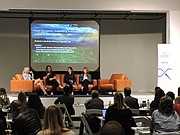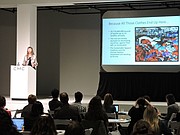MANUFACTURING
Eco-Collaboration Promoted During First Sustainable Apparel Coalition Event in L.A.
Bringing together experts and apparel-industry veterans, the Sustainable Apparel Coalition hosted its first Los Angeles event at the California Market Center on April 24. The organization works within the apparel industry to lead sustainable, ethical initiatives by limiting environmental impact and promoting social welfare for garment workers.
During “The Future of Design” workshop, the organization introduced tools for a better apparel industry and invited speakers from companies implementing sustainability efforts. After learning about the Los Angeles apparel-manufacturing industry by working at his family’s business, Scott Miller is now the director of business development for SAC.
Following the event, he reported that his organization was successful in showing attendees that collaboration is key to an improved, cleaner apparel industry.
“We brought together brands, retailers, service providers and academics in the same room to sit next to each other—perhaps even competitors,” he said. “We drive them to design sustainable fashion on-site and show them that we are all together living on this planet. If we don’t come together on the concepts related to sustainable design in the precompetitive space, we will all suffer the consequences.”
Setting the tone for a shared mission, Ricardo Vazquez, who is the economic-policy manager for the City of Los Angeles, provided opening remarks. He felt his presence at the event was important to show the apparel industry that the city is interested in working with manufacturers and designers for a cleaner city.
He said Mayor Eric Garcetti on April 29 will relaunch the L.A. Sustainability Plan. “By 2050, our goal is to have zero waste to landfills. We are here to partner with the industry to plan how we can help get there,” he said. “We want this to be a partnership. That is going to be the first step. We’re in the early stages of what our action plan will be with the industry.”
Susanna Schick, a speaker and product development consultant at Sustainable Fashion Los Angeles, encouraged guests to consider working with consumers to develop resale initiatives such as the model followed by reseller The RealReal and buyback programs similar to the apparel brand Patagonia. She outlined how a resale program could benefit both the environment and business.
“Manufacturers who don’t have a takeback program are missing out tremendously,” she said. “Not only do you get to resell your clothing and make money on it again but you also get to understand the clothing items people keep—the bodies, styles and colors. What are the things that become loved clothes that last?”
During the event, the Sustainable Apparel Coalition also showed how its sustainability-measurement tool—The Higg Index—can be used to ensure brands are progressing toward more ethical and ecologically sound practices. The Higg Index has become a benchmark for companies at every stage along the supply chain to monitor and remain accountable for their contributions to a sustainable industry.
While Miller emphasizes the urgency for the apparel industry to adopt more beneficial practices, he recognizes that small steps can mean greater progress over time.
“It’s possible to adopt incremental change and have the ability to make sustainability decisions within the design phase without conceivably increasing cost,” he explained. “It is absolutely a business and planetary imperative that our industry embrace circular and regenerative production concepts immediately.”
The breakthrough regarding how to start small was reached during a panel discussion covering “Embedding Sustainability, Case Studies and Best Practices.” Moderated by Julie Brown, SAC’s director of The Higg Index, the panel included Rachel Lincoln, director of sustainability and product operations for Prana; Elena Egorova, environmental researcher at Patagonia; and Jaclyn Allen, director of corporate sustainability for Guess.
The discussion addressed concerns of apparel-industry professionals who want to implement sustainable practices but feel overwhelmed by the seemingly insurmountable task of becoming an eco-friendly and ethical brand while still remaining profitable. Lincoln outlined the path toward reaching this sustainable-apparel goal by referring to the steps she took to develop her Spring 2020 swimwear line using all recycled materials.
“First we did all of our solids, then recycled polys, then nylons and baby-stepped our way into it. We could afford the 1 percent margin degradation here—and we funded it by moving more inventory—maybe earning the 1 percent over there,” she said. “It’s not about compromising the business. It’s what are we going to leverage to support this area of our business?”
For Miller, the event’s presence in Los Angeles was important due to the city’s history and continued role as an apparel-manufacturing capital. While he recognizes that some brands have been slow to adopt sustainable practices, he noted that the shift is inevitable.
“It’s time to wake up to the call of the scientific community in particular to boldly address the sustainability impacts of our industry,” he said. “There are some companies that are truly stepping it up. I would not be shocked if these are the companies that come out of this ahead of others that are sitting back and continuously adopting the status quo, which is over.”























